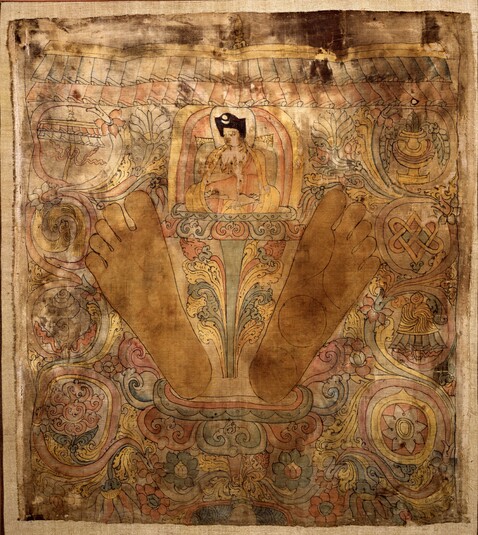
Item: Teacher (Lama) - Karmapa
| Origin Location | Tibet |
|---|---|
| Date Range | 1200 - 1299 |
| Lineages | Kagyu, Karma (Kagyu) and Buddhist |
| Size | 54.61x48.26cm (21.50x19in) |
| Material | Ground: Silk |
| Collection | Rubin Museum of Art |
| Catalogue # | acc.# F1997.32.2 |
Classification: Person
Footprints of a Karmapa belonging to the Karmapa incarnation lineage of the Karma Kagyu Tradition of Tibetan Buddhism. The footprints are accompanied by the Eight Auspicious Symbols on the right and left. This is possibly the 1st Gyalwa Karmapa, Dusum Kyenpa (1110-1193 [83 yrs]), the 2nd Gyalwa Karmapa, Karma Pakshi (1204-1283 [79 yrs]), or the 3rd Gyalwa Karmapa, Rangjung Dorje (1284-1339 [55 yrs]). Because of the prominence of the black hat it is probably unlikely to be the 1st Karmapa. The hat is also very large compared with the smaller and more simple hat typically worn by the 2nd Karmapa.
The main subject of the painting is the large pair of footprints in the center of the composition. They are both painted in gold and adorned with a circle (on the right), representing a wheel symbolizing the teachings of the Buddhist religion, at the hollow of the foot. The two feet situated on the heels stand atop a moon disc and multi-coloured lotus seat. Again below that is the stem of the lotus seat springing forth from a blue pond at the bottom of the composition.
Between the two feet is an ornate stylized flower stem with vines and flowers unfurling. At the top a flower supports the figure of Karmapa. He wears a black cap adorned with a sun and moon. The hands are in the gesture of teaching and the legs folded in vajra posture. He looks slightly to his right.
At the left and right of the two feet are the Eight Auspicious Symbols entwined in a vine motif: (1) Parasol, (2) Golden Fish, (3 ) Treasure Vase, (4) Lotus, (5) Right-turning Conch Shell, (6) Glorious Endless Knot, (7) Victory Sign and (8) Wheel.
Another painting of a Karmapa and footprints in a private collection has a very similar composition as the Rubin painting with the placement of the feet, central column topped by a figure wearing a black cap, and the Eight Auspicious Symbols decorating the sides framed in a vine and flower motif. Based on the private collection painting the Rubin painting can be identified as very likely a depiction of the 3rd Karmapa. The two paintings are appear created at a similar time based on the similarity of ornaments and the Eight Auspicious Symbols.
The custom of having drawings done based on the physical outline of a teachers feet appears to be an oral instruction coming down from Gampopa Sonam Rinchen. The most famous early text describing this practice was written by Pagmodrupa Dorje Gyalpo - a direct student of Gampopa. Dusum Kyenpa, the 1st Karmapa, was also a direct student of Gampopa. Currently there are only four paintings known - in the East or the West - depicting a Karmapa and footprints. (See the Handprints and Footprints Main Page and Outline Page).
Jeff Watt 12-2010
Front of Painting
Special Features: (footprints)
Reverse of Painting
Special Features: (includes "Om Ah Hum" inscription)
Exhibition: Mirror of the Buddha
Publications
Publication: Worlds of Transformation
Publication: Eternal Presence
Thematic Sets
Collection of RMA: Best of Collection 3
Subject: Footprints & Handprints (Kagyu)
Subject: Karmapa (Early Paintings)
Incarnation Lineage: Karmapa (Handprints & Footprints)
Incarnation Lineage: Gyalwa Karmapa Main Page
Collection of Rubin Museum of Art: Mandala
Subject: Footprints (Lamas)
Teachers: Early Paintings of Teachers (Indian Style)
Teachers: Early Teachers (Right Facing)
Subject: Footprints & Handprints (Footprints Only)
Teachers: Early Teachers (Single Figures)
Subject: Footprint Paintings (Early Works)
Collection of Rubin Museum of Art: Painting Gallery 3
Painting Style: Indian (11th to 13th century)
Subject: Footprints & Handprints Main Page
Tradition: Karma Kagyu Teachers (Early Paintings)
